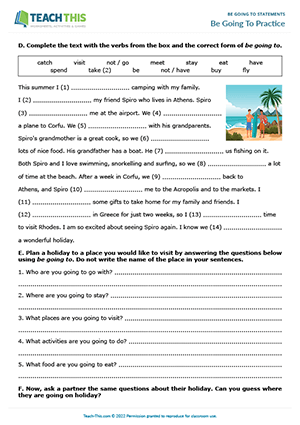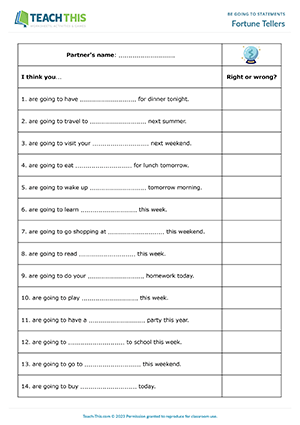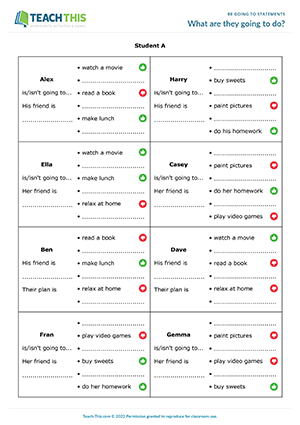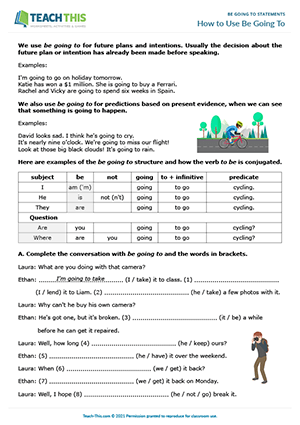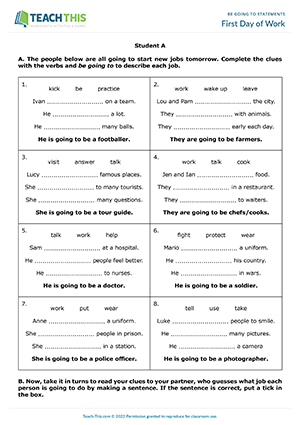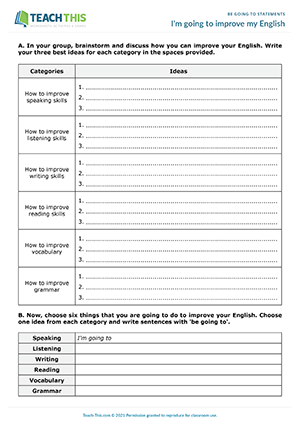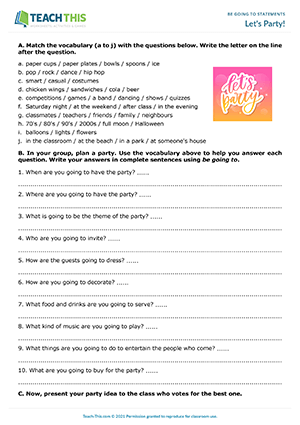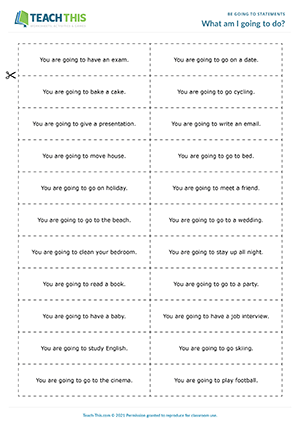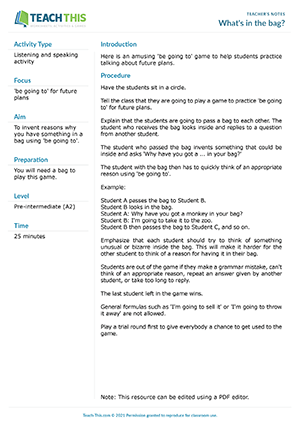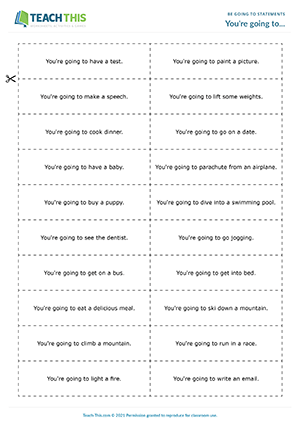This free be going to worksheet helps students practice positive and negative be going to statements. First, students label be going to sentences as a prediction or a plan. Next, students match sentence halves to form be going to statements. After that, students complete sentences by underlining the correct verb forms. Students then complete a text with verbs from a box and the correct form of be going to. Students then move on to plan a holiday to a place they would like to visit by answering questions using be going to. However, students must not name the place in their sentences. Finally, students ask a partner the same questions and try to guess where they are going on holiday.
In this engaging be going to game, students practice affirmative and negative be going to statements by predicting a partner's future plans. Without speaking to their partner, students complete affirmative be going to statements that predict their partner's future plans by guessing the information and writing it in the spaces provided. Next, students take turns reading each statement to their partner, e.g. 'I think you are going to have fish for dinner tonight.' Their partner then tells them if their guess is right or wrong. If the guess is right, the student puts a tick in the box. If the student's guess is wrong, their partner gives the correct information by first making a negative be going to statement followed by an affirmative one, e.g. 'I'm not going to have fish for dinner tonight. I'm going to have a pizza for dinner tonight.' The student then writes the correct information in the box, e.g. pizza. The student with the most correct guesses at the end of the game wins.
In this be going to speaking activity, students describe people's weekend plans using is going to and isn't going to. In pairs, students take turns telling their partner what a person from the worksheet is and isn't going to do at the weekend. A thumbs-up indicates that the person is going to do the activity and a thumbs-down shows what the person isn't going to do, e.g. 'Alex is going to do his homework.' Their partner listens and fills in the blanks on their worksheet with the activities, putting a tick or cross accordingly. When the students have finished, they compare each person's list of activities to find pairs of people who are going to do the same things, writing each person's friend's name as indicated.
This useful be going to worksheet helps to teach students how to use be going to for future plans, intentions and predictions. To begin, students read about the functions of be going to and look at examples of how the be going to structure is used and formed. Students then complete a dialogue to practice the structure. Next, students practice making predictions with be going to based on present evidence. After that, students think about what they are going to be like in the year 2050. Students then make sentences about their future using be going to for future plans, intentions and predictions. Finally, in groups, students tell their group members what they think they are going to be like in the future.
In this fun be going to guessing game, students create clues for jobs that people are going to do for a partner to guess. To begin, students complete clues for each person's job using be going to and the verbs provided. In pairs, students then take turns reading their clues to their partner, who guesses what job each person is going to do by making a sentence. If their partner says the be going to sentence shown in bold, the student puts a tick. The student with the most correct guesses at the end of the game wins.
In this free be going to speaking activity, students talk about future intentions by discussing ways to improve their English. In groups, students brainstorm and discuss how they can improve their English in six categories, e.g. speaking, listening, writing, etc. Students then choose the best three ideas for each category and each student notes these down on their worksheet. Working alone, students then choose six things that they are going to do to improve their English, choosing one idea from each category and writing a sentence with be going to, e.g. 'I'm going to speak English for one hour a day.' Next, students pair up with someone from another group. Students then compare their ideas with their partner and give reasons for their choices. Finally, there is a class feedback session to find out which were the most popular ideas for improving English skills.
In this creative be going to activity, students plan a party and then present their plans to the class. To begin, students match vocabulary to questions about planning a party. Then, in groups, students plan a party by answering ten be going to questions on the worksheet using the party vocabulary from the first exercise to help them answer each question. Students write their answers in sentence form using be going to. When each group has planned their party, they present their party idea to the class by reading their sentences. The class then votes for the best one.
In this predictions with be going to game, students play a game of dominoes by matching be going to predictions to situations and vice-versa. The first player puts a domino down either before or after the domino on the table, making sure their situation or prediction matches with what’s shown on the other domino. The next player then tries to put down one of their dominoes at either end of the domino chain, and so on. The first player to get rid of all their dominoes wins the game.
In this entertaining be going to game, students give clues about planned activities by saying what they are going to do beforehand. In pairs, students take turns picking up a card and telling their partner one thing they are going to do before they start doing the planned activity on the card, e.g. 'I’m going to read my textbook.' Their partner then tries to guess what they are going to do next, e.g. 'You are going to have an exam.' If their partner guesses correctly, they keep the card. If their partner guesses incorrectly, the student gives them up to three more clues. If their partner still cannot give the right answer, the student keeps the card. The student with the most cards at the end of the game is the winner.
In this amusing be going to game, students invent reasons why they have something in a bag using be going to. Students sit in a circle and pass a bag to each other. The student who receives the bag looks inside. The student who passed the bag then invents something unusual or bizarre that could be inside and asks a 'Why have you got ... in your bag?' question to the student, e.g. 'Why have you got a monkey in your bag?' The other student quickly thinks of an appropriate reason and responds using be going to, e.g. 'I'm going to take it to the zoo.' Students are out of the game if they make a grammar mistake, can't think of an appropriate reason, repeat an answer given by another student or take too long to reply. The last student left in the game wins.
In this imaginative be going to game, students watch mimes and guess what is going to happen next by making be going to statements. A player from one team comes to the front of the class and is given a card. The player mimes the actions they would do in preparation for the planned activity marked on the card, but they don't do the activity itself. Instead, they stop just before and say, "What am I going to do next?" The player's team then consults before answering using the phrase 'You're going to...' If the player's team answers correctly, they score two points. If the player's team gives the wrong answer, the other team is allowed to guess for one point. Then, a player from the other team comes to the front of the class, and so on. The team with the highest score at the end of the game wins.
Latest Free
Resources
- Everyday Objects Bingo
Everyday Objects
Elementary (A1-A2)
- Action Verb Races
Actions
Elementary (A1-A2)
- Birthday Basics
Birthdays
Elementary (A1-A2)
- Sales Phrasal Verbs
Business Phrasal Verbs
Upper-intermediate (B2)
Latest Member
Resources
- Collocations at Work
Business Collocations
Intermediate (B1)
- Etiquette Trivia Board Game
Etiquette and Manners
Upper-intermediate (B2)
- Everyday Objects Vocabulary
Everyday Objects
Pre-intermediate (A2)
- Let's have a talk
Verb-Noun Collocations
Pre-intermediate (A2)



